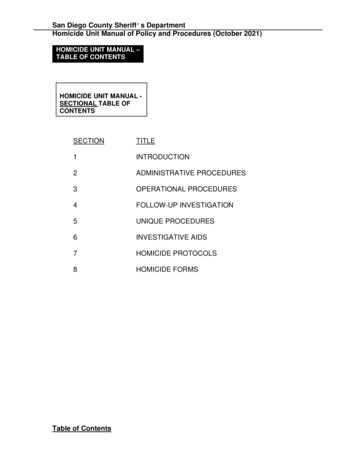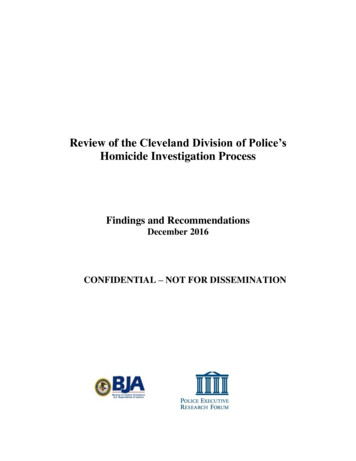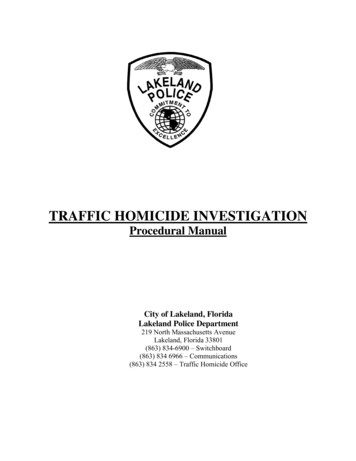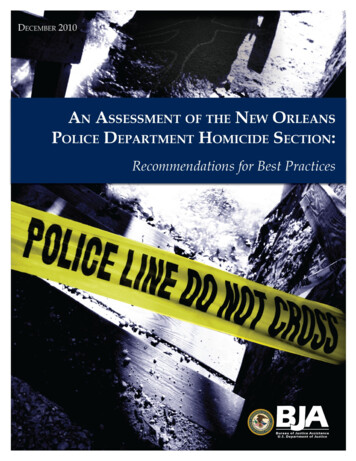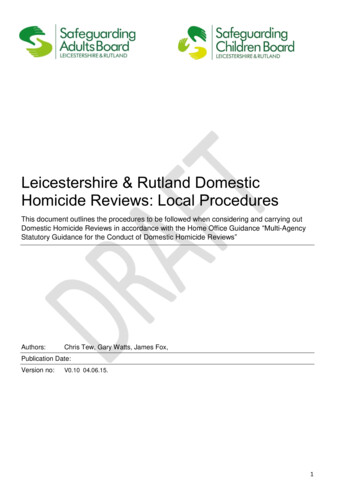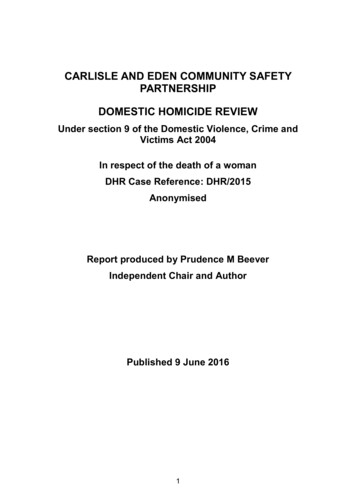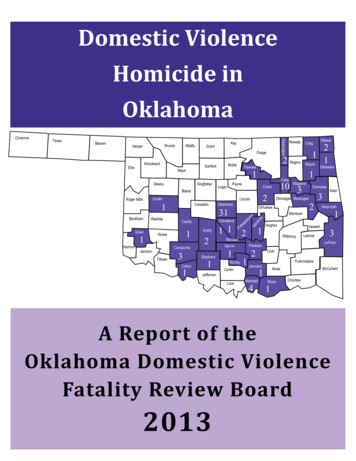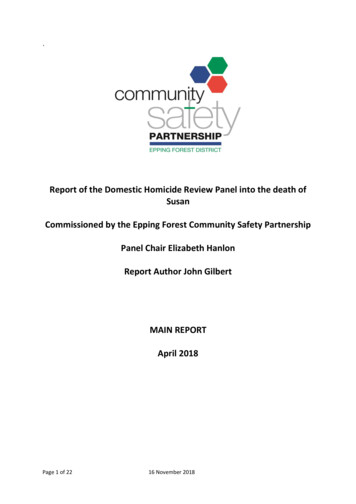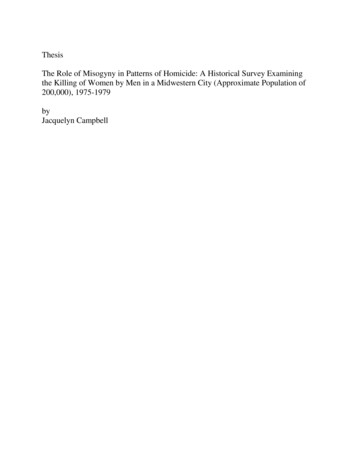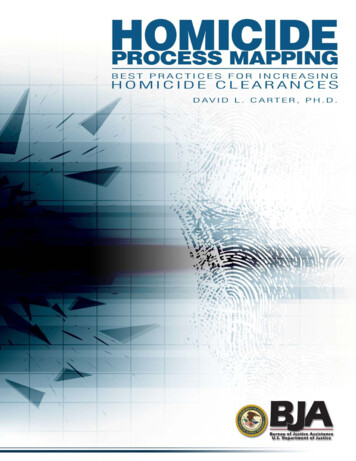
Transcription
/BEST PRACTICESFORINCREASINGHOMICIDE CLEARANCESDAVIDL . CARTER ,PH . D .
This project was supported by Grant No. 2009-D2-BX-K001 awarded to the Institute for Intergovernmental Research (IIR) bythe Bureau of Justice Assistance. The Bureau of Justice Assistance is a component of the office of Justice Programs, which alsoincludes the Bureau of Justice Statistics, the National Institute of Justice, the Office of Juvenile Justice and DelinquencyPrevention, the Office for Victims of Crimes, and the SMART Office. The opinions, findings, and conclusions orrecommendations expressed in this publication are those of the author and project team members and do not necessarily reflectthe views of the U.S. Department of Justice.A Project of the U.S. Department of Justice, Office of Justice Programs, Bureau of Justice Assistance. Copyright 2013 Institutefor Intergovernmental Research . All rights reserved.
David L. Carter, Ph.D.September 2013
Dear reader:One homicide victim is one too many. Yet we also understand the challenging and quitecomplex nature of homicide investigations. Homicide, homicide investigations, clearancerates, and productive communication with the public are all critical concerns for lawenforcement and communities nationwide. And despite recent across-the-boardimprovements in homicide clearance rates, we know that we can do better.How are some agencies so successful in their homicide investigations? What are the ingredients forsuccessful homicide investigations? What can law enforcement executives do to support homicideinvestigations, investigators, and the communities they serve?To answer these questions, the U.S. Department of Justice, through the Office of Justice Programs’ Bureauof Justice Assistance (BJA), partnered with the International Association of Chiefs of Police (IACP) and theInstitute for Intergovernmental Research (IIR) to gather data, evidence, and best practices from several lawenforcement agencies around the country in an effort to share their successes with you.As a result, I am pleased to announce two similar, yet complementary, publications that represent BJA’songoing commitment to reducing crime and violence through evidence-based and results-driven efforts. Onepublication details effective investigative practices; the other focuses on the administrative environmentnecessary to support successful homicide investigative outcomes. Together, they will assist law enforcementexecutives and homicide units in effectively managing homicide investigations.The first publication, Homicide Process Mapping: Best Practices for Increasing Homicide Clearances,provides insight into “what works” in homicide investigations and identifies effective approaches and keyelements of practice for managing these investigations. The resulting “process map” is offered as a guide forincreasing clearances in U.S. law enforcement homicide investigations.The second publication, 10 Things Law Enforcement Executives Can Do to Positively Impact HomicideInvestigation Outcomes, looks beyond clearance rates to offer a starting point for executives to extend theirsupport of homicide investigations, investigators, and their communities.Each component highlighted in these publications—administration and investigation—is essential foreffective policing. I encourage you to read both publications. They can be found at the BJA, IACP, and IIRweb sites: www.bja.gov, www.theiacp.org, and www.iir.com.I want to thank the IACP and IIR for their work in producing such practical and relevant publications. BJA,IIR, and IACP have a longstanding relationship and a shared interest in promoting promising practices in lawenforcement. It is our sincere hope that every law enforcement agency in the nation can improve homicideinvestigations by adopting practices identified in these publications.Sincerely,Denise E. O’DonnellDirector
HOMICIDE PROCESS MAPPING:BEST PRACTICES FOR INCREASING HOMICIDE CLEARANCESTable of ContentsExecutive Summary . iIntroduction . 1The Application of Process Mapping to Homicide Investigation . 2Project Goal and Perspective . 2Methods. 3Table 1: Population and Sworn Officer Data . 4Table 2: 2008–2010 Three-Year Average Homicide and Clearance Data . 4Table 3: 2011 Homicide and Clearance Data . 4Findings. 6Strategic Initiatives and Practices . 7Tactical Initiatives and Practices . 13Richmond: A Comprehensive Integrated Approach . 23Implications. 25A Summary of Best Practices . 27The First 48 Hours of a Homicide Investigation . 32Figure 1: Functions of Each Time Interval in the First 48 Hours . 33Tasks During the First 48 Hours of a Homicide Investigation . 36Appendix A—Project Team . 41Appendix B—Homicide Callout Worksheet . 43Appendix C—Homicide Investigation Briefing Script. 49Resources . 53
HOMICIDE PROCESS MAPPING:BEST PRACTICES FOR INCREASING HOMICIDE CLEARANCESExecutive SummarySince 1990, the number of homicides committed in the United States has dropped over30 percent.1 While this is a positive trend, it is somewhat counterbalanced by another trend: inthe mid-1970s, the average homicide clearance rate in the United States was around 80 percent.Today, that number has dropped to 65 percent—hence, more offenders are literally getting awaywith murder.2The Bureau of Justice Assistance (BJA), a component of the U.S. Department of Justice’sOffice of Justice Programs (OJP), recognizes that the problem of violence in the United Statesrequires a multifaceted approach. In a coordinated initiative of projects, BJA has examined themanner in which trends in violence are identified by law enforcement for tactical purposes,3reviewed how cutting-edge analysis and the integration of resources can disrupt trends in violentcrime,4 and examined two decades of violence-reduction initiatives to determine what works.5Based on lessons learned, new initiatives are explored, such as the Law Enforcement ForecastingGroup (LEFG), which produced a paper on the importance of the analytic process for crimecontrol (tactically) and resource allocation for crime reduction (strategically). 6 Collectively, thelessons from these initiatives—and other initiatives by BJA and companion OJP components—provide guidance on new avenues to explore.Based on the findings from these projects, one of the focal points in violence suppressioninitiatives that BJA explored was the most efficacious method to manage homicideinvestigations. Two paths were used toward this end. The current project on Homicide ProcessMapping focused on investigative practices. A companion project by the InternationalAssociation of Chiefs of Police (IACP), 10 Things Law Enforcement Executives Can Do toPositively Impact Homicide Investigation Outcomes, focused on the administrative environmentin support of homicide investigations.7 Both are essential for successful investigations.The purpose of this project was to identify best practices in homicide investigations thatwill result in an increase in homicide clearance rates. To accomplish this goal, cations/wellford.pdf.3Police Executive Research Forum (2013), Compstat: Its Origins, Evolution, and Future in Law EnforcementAgencies, Washington, DC, U.S. Department of Justice, Bureau of Justice ompstat.pdf.4The Center for Community Safety (2013), Winston-Salem Intelligent-Led Policing: A Blueprint for Implementing,Washington, DC, U.S. Department of Justice, Bureau of Justice B4-WinstonSalem-ILP.pdf.5Michigan State University and University of Illinois at Chicago (2013), “Promising Strategies for ViolenceReduction: Lessons From Two Decades of Innovation,” Project Safe Neighborhoods Case Study Report #13,Washington, DC, U.S. Department of Justice, Bureau of Justice Assistance,https://www.bja.gov/Publications/MSU PromisingViolenceReductionInitiatives.pdf.6Law Enforcement Forecasting Group (2012), Increasing Analytic Capacity of State and Local Law EnforcementAgencies: Moving Beyond Data Analysis to Create a Vision for Change, Washington, DC, U.S. Department ofJustice, Bureau of Justice Assistance, lyticCapacity.pdf.7International Association of Chiefs of Police (IACP) (2013), 10 Things Law Enforcement Executives Can Do toPositively Impact Homicide Investigation Outcomes, Washington, DC, U.S. Department of Justice, Bureau of JusticeAssistance, http://www.theiacp.org.2i
HOMICIDE PROCESS MAPPING:BEST PRACTICES FOR INCREASING HOMICIDE CLEARANCESgeographically representative law enforcement agencies were identified that had at least 24homicides in 2011 and had a clearance rate of 80 percent or higher. In addition, because the first48 hours of a homicide investigation are critical, the project identified critical tasks in the first 48hours of the investigation that increase the probability of a clearance. The selected agencies,both municipal and county, were the Baltimore County, Maryland, Police Department; theDenver, Colorado, Police Department; the Houston, Texas, Police Department; the Jacksonville,Florida, Sheriff’s Office; the Richmond, Virginia, Police Department; the Sacramento County,California, Sheriff’s Department; and the San Diego, California, Police Department.Each site was visited by two experienced homicide investigators and a police researcherwho conducted interviews and reviewed documents. Interviews were conducted with thehomicide commander, homicide supervisors, homicide investigators, and other personnel whoeach department believed were important in aiding successful homicide investigations.Following the collection of all information, the findings were broken down into strategic andtactical issues. Each of these is discussed in this report from a policy implementationperspective. This is followed by a summary of homicide investigation best practices that at leasttwo agencies reported using. The report concludes with a process map that identifies criticalinvestigative tasks to be performed in the first 48 hours after a homicide is reported. The processmap is the product of a detailed analysis and integration of the processes used by the agencies inthis project.While many factors contributed to successful homicide investigations, including somecreative practices, there was one overarching factor: all of the agencies visited had laid a strongfoundation of trust with the community and a strong foundation of cooperation and informationsharing with other law enforcement agencies. Without this foundation, success will be limited.ii
HOMICIDE PROCESS MAPPING:BEST PRACTICES FOR INCREASING HOMICIDE CLEARANCESIntroductionThe United States has experienced tragic mass homicides—such as Newtown,Connecticut, and Aurora, Colorado—that focus national attention on the crime. However,receiving much less national attention is the fact that on average there are more than 40homicides occurring on a daily basis in the United States.8 This number surpasses the deathsthat occurred in these horrific mass incidents. Although over the last several years the numbersof homicides nationwide have continued to drop, the numbers of victims still remain high(16,799 homicides in 2011) (Cooper and Smith, 2011). Moreover, another disturbing trend hasemerged. While the frequency of homicides is decreasing, clearance rates have also dropped (toless than 65 percent on average);9 hence, fewer homicide offenders are being identified andarrested.Although the national clearance rate average has continued to drop, some individual lawenforcement agencies have excelled in clearing homicides, with clearance rates of 80 percent andhigher. The Bureau of Justice Assistance (BJA) wanted to understand how some agencies wereso successful in their homicide investigations. Was it because of personnel? Training? Budget?Technology? Management? Investigative Techniques? Forensics? Equipment? While it wassuspected that all of these factors played a role, there was no clear answer. However, if theingredients to successful homicide investigations could be identified, then a recipe of goodpractices could be articulated so that other law enforcement agencies could model theirinvestigative procedures in order to help increase the successes of their investigations.Beyond the techniques and resources used in a homicide investigation, it has been learnedthat a fast, effective response to a homicide call can play a significant role in the success of aninvestigation—particularly in the first 48 hours after the police are notified of a homicide. Areagencies with higher clearance rates performing unique investigative tasks in the first 48 hours?What are the critical successful and/or unique tasks that must be done in the first 48 hours whichwill increase the probability of an arrest? Although many of these investigative tasks are known,their specific sequence and method of performance can be less clear depending on the facts andcircumstances that are known in the early stages of the investigation.Finally, are new techniques and practices that are based on broader developments ofpolicing—such as community policing, intelligence-led policing, evidence-based policing, orCompstat—making homicide investigations more successful? While it is suspected that acombination of these factors contributed to successes in homicide investigations, the details andapplicability have not been documented.To answer these questions, BJA initiated the Homicide Process Mapping project. Theintent was to identify high-performing geographically represented law enforcement agencies tolearn what made them investigative arances.1
HOMICIDE PROCESS MAPPING:BEST PRACTICES FOR INCREASING HOMICIDE CLEARANCESThe Application of Process Mapping to Homicide InvestigationThe concept of process mapping has its roots in the scientific management movement ofthe early twentieth century. The principles were essentially to: Study and understand the nature of the work to be performed and find the bestway to perform the tasks of the work. Select the best persons to perform the work and train them on the mostefficient way to perform the tasks. Measure the success and productivity of the work to ensure that the intendedaccomplishments are being achieved (Taylor, 1910).As scientific management evolved, greater attention was given to the sequence and flowof tasks in the processes required to accomplish the work. In order to more easily visualize thesetasks, flowcharts—or process maps—were developed. The process maps provide direction,accountability, and a method to assess task performance.The use of process mapping became even more refined in the 1960s to 1970s with thegrowth of computers. Flowcharts were used to plan each instruction and computation insoftware development. This detailed expansion of the practice in software development wasreciprocated to its roots in management, thereby permitting more sophisticated application tocomplex business tasks.A homicide investigation consists of a complex array of tasks that must be performed,initially, over a short period of time, often under significant stress. The tasks are furthercomplicated because they must meet a range of legal standards, conform to scientific integrityfor later forensic analysis, or require dealing with challenging human relationships. Other tasksare influenced by external pressures—such as the community or elected officials—to ensure thatthe tasks are performed quickly, accurately, and successfully.Project Goal and PerspectiveThis project focuses on the capabilities of the investigating agency to successfully clearcriminal homicide cases. A homicide is “cleared” when the offender(s) has(have) been identifiedand there is a disposition of the offender related to the specific homicide in question, througheither a “clearance by arrest” or a “clearance by exception.”1010An offense is cleared by arrest or solved for crime reporting purposes when at least one person is (1) arrested,(2) charged with the commission of the offense, and (3) turned over to the court for prosecution (FBI 2004:79). Ifan individual has committed multiple homicides and is arrested for each of those homicides, then all of thosehomicides are cleared by the arrest of one individual. Only an arrest, not a conviction, is required to clear the casefor Uniform Crime Reporting purposes. A case may be declared as “exceptionally cleared” if all four of thefollowing questions can be answered in the affirmative:1. Has the investigation definitely established the identity of the offender?2. Is there enough information to support an arrest, a charge, and a formal charging of the suspect with acriminal homicide offense?2
HOMICIDE PROCESS MAPPING:BEST PRACTICES FOR INCREASING HOMICIDE CLEARANCESA clearance rate is the percentage of all reported criminal homicides within a jurisdictionthat have been cleared by arrest and exception combined. Obviously, clearance rates among lawenforcement agencies vary widely for a variety of reasons, ranging from the facts of the case tothe capabilities of the investigating agency.Why are some agencies more successful at clearing homicides than others? Oneimportant reason is capability. There are a number of steps in the investigative process that areessentially standard practice, ranging from the collection and analysis of forensic evidence tointerviewing witnesses and suspects. Evidence from this project suggests that there is acontinuum of competence in performing these tasks that will influence their effectiveness. Whyare some agencies more competent than others? There appears to be a variety of reasons: astronger professional fabric, the investment of time and effort to build trust within thecommunity, a willingness to challenge the status quo in performing investigative tasks, and aprofessionally developed and trained investigative workforce are certainly among the reasons.Resources can also contribute to greater success; however, this is also often an excuse—it is notonly the amount of resources but also how the resources are used. Stated simply, some agenciesjust do the job better.Can effective investigative practices also prevent homicides? The evidence suggests“yes” in some cases. Effective investigations can eliminate repeat offenders and reduce thenumber of retaliation homicides. Although prevention is not the direct goal of homicideinvestigators, it can be an important artifact of a substantively strong investigation.This project seeks to define strategies and tactics that can be employed by a lawenforcement agency to increase the number of homicides that are cleared by arrest.MethodsThe baseline criterion for selecting jurisdictions in this project was that the jurisdictionhad at least 24 homicides and a homicide clearance rate greater than 80 percent in 2011.11 Inaddition, the project looked for a combination of municipal police departments and county lawenforcement agencies with geographical representation throughout the United States. Usingthese criteria, a number of agencies were identified and contacted to determine whether theywere willing to participate in this project, to include setting time aside for a team to visit theagency, interview investigators and other relevant personnel, and review documents. After thisvetting process and discussion among the project team, seven agencies were identified. 12 Theselected sites and relevant data are depicted in Tables 1, 2, and 3.3.4.Is the exact location of the offender known so that the subject could be taken into custody now?Is there some reason outside law enforcement control that precludes arresting, charging, and prosecutingthe offender? (FBI 2004:80–81)For example, in a murder-suicide, the suicide of the offender essentially clears the case.11The project started in 2012, so the most current full year of available data was 2011.12Financial constraints were also a factor to limit the number of agencies participating.3
HOMICIDE PROCESS MAPPING:BEST PRACTICES FOR INCREASING HOMICIDE CLEARANCESTable 1: Population and Sworn Officer Data# of SwornAgencyPopulation13Personnel14Baltimore County, MD, Police DepartmentDenver, CO, Police DepartmentHouston, TX, Police DepartmentJacksonville, FL, Sheriff’s OfficeRichmond, VA, Police DepartmentSacramento County, CA, Sheriff’s DepartmentSan Diego, CA, Police 50,1211,326,1791,8771,4205,2941,6457271,1931,834# of HomicideInvestigators1515131303121927Table 2: 2008–2010 Three-Year Average Homicide and Clearance eAverageAverageAgencyNumber ofHomicidesClearanceHomicides16Per 100,000Rate17Baltimore County, MD, Police DepartmentDenver, CO, Police DepartmentHouston, TX, Police DepartmentJacksonville, FL, Sheriff’s OfficeRichmond, VA, Police DepartmentSacramento County, CA, Sheriff’s DepartmentSan Diego, CA, Police 623.0991.0%80.0%82.0%76.0%87.0%91.0%115.0%18Table 3: 2011 Homicide and Clearance DataAgency2011 Numberof Homicides19HomicidesPer 0.0%Baltimore County, MD, Police DepartmentDenver, CO, Police DepartmentHouston, TX, Police DepartmentJacksonville, FL, Sheriff’s OfficeRichmond, VA, Police DepartmentSacramento County, CA, Sheriff’s DepartmentSan Diego, CA, Police Department132012 population estimates by the U.S. Census Bureau, his number represents sworn personnel assigned exclusively to homicide investigations and includes all ranks.This number does not include cold case squads.162008–2010 average homicide data compiled from analysis of FBI Uniform Crime Reporting (UCR) data forcorresponding years.17Discrepancies may occur between data published by the FBI and individual agencies because of different methodsof calculating clearance rates. For consistency across all agencies, officially reported and published FBI UCR dataare used in this report.18The clearance rate can exceed 100 percent because of the UCR methodology. Homicides may be cleared that werecommitted in a previous year, hence increasing the clearance rate for that year. For example, a homicide committedon December 31, 2013, will count in the 2013 crime rate. If the person who committed the homicide is arrested thenext day—January 1, 2014—the clearance by arrest will be counted in the 2014 crime me/murder.144
HOMICIDE PROCESS MAPPING:BEST PRACTICES FOR INCREASING HOMICIDE CLEARANCESTo carry out this project, BJA assigned Senior Policy Advisor Michael Medaris, who hasmore than 21 years of law enforcement experience, to manage the project and to providedirection and guidance on project activities. BJA selected five experienced homicideinvestigators with recognized expertise, representing different ranks in their agencies. Inaddition, an experienced law enforcement researcher was selected as team leader, who wasresponsible for collating and analyzing the collected information as well as writing the projectreport. At least two investigators20 and the researcher performed each site visit. In addition, theInstitute for Intergovernmental Research21 (IIR) provided staff and logistical support for theproject.To ensure that key information related to the project goal was collected from each sitevisit, as well as to ensure reliability across all site visits, a set of core questions was developed.All team members reviewed the questions. After two iterations of review and refinement, anelectronic final copy was sent to all team members, who then brought a hard copy to each sitevisit. Importantly, the questions were for baseline information only.At each site, the team requested to interview, at a minimum, the homicide investigationcommander, a homicide investigation supervisor, and a homicide investigator.22 Becausedifferent agencies had different programs or functions that contributed to their success, the teamrequested interviews with those personnel that the agency identified as being important to thesuccess in achieving homicide clearance rates. The fewest number of people interviewed was 5;the largest number was 14. In each case, the team asked the supervisor and investigator toidentify and discuss the importance of programs or personnel as they contributed to the successof the investigation. This was followed by interviews with those personnel. For example, inSacramento County, the supervisor and investigator described the importance of the MajorCrimes Bureau in tracking down homicide suspects. This was followed by an interview of theMajor Crimes Bureau Supervisor.At the end of each site visit interview session, the supervisor and investigator were askedto “walk through” the first 48 hours of a homicide investigation and describe the specific taskstheir unit performed, with an estimate of the time frame in which each task was performed.These findings were integrated and served as the foundation for the process map found at the endof this report. It is estimated that there were approximately 120 total interview hours in thisproject.Following the site visit, team members would meet to discuss key elements learned in thesite visits and to ensure that each team member agreed on the findings. If there were gaps of20Five investigators were selected as team members who rotated between the site visits, depending on theiravailability based on their schedules.21http://www.iir.com/.22In some locations, the term investigator was used, while other locations used detective. In some cases, detectivewas a rank, while in others, it was simply a job description. Similarly, in some cases a lieutenant was the first-linesupervisor, while in others, the lieutenant was either a shift commander or the homicide unit commander. Otherorganizational distinctions existed, such as referring to the homicide investigation function as a “unit,” a “bureau,”or a “division.” For consistency and greater ease in comparison for this report, the writing convention is to use theterms unit, commander, supervisor, and investigator for describing all agencies.5
HOMICIDE PROCESS MAPPING:BEST PRACTICES FOR INCREASING HOMICIDE CLEARANCESinformation or different interpretations, the team leader would recontact the agency to clarify theissue.After each site visit was completed, participating team members prepared a report of theirobservations, important points, and best practices used by the agency. These reports were sent tothe team leader to be used in the analysis of the information. The team leader integrated all ofthe material, performed a qualitative analysis, and drafted the report. The draft report was thensent to the team members for their review. The final report reflects a consensus finding from theteam.As the project evolved, team members observed that these successful law enforcementagencies were not simply applying a new technology or implementing a promising practice.Rather, they had reexamined the role of the homicide investigator, the methodology of homicideinvestigations, and the relationship of homicide investigations to other units within thedepartment as well as with other agencies. Many proven investigation techniques still apply, butthrough a different paradigm, to make them more effective, with new insight about theapplication of the technique. In addition, new techniques and an evolved organizationalphilosophy of homicide investigations can help increase the effectiveness of these inquiries.FindingsAll of the agencies in this project are full-service law enforcement agenci
Appendix C—Homicide Investigation Briefing Script . 49 Resources 53. . investigative procedures in order to help increase the successes of their investigations. Beyond the techniques and resources used in a homicide investigation, it has been learned that a fast, effective response to a homicide call can play a significant role in the .
